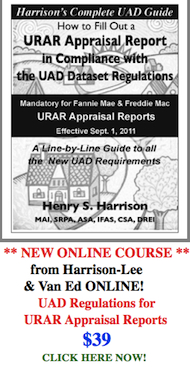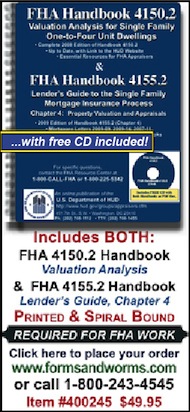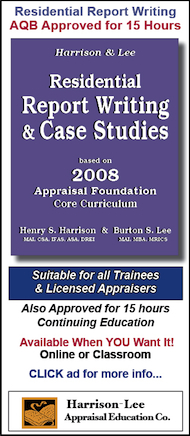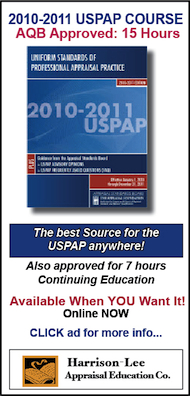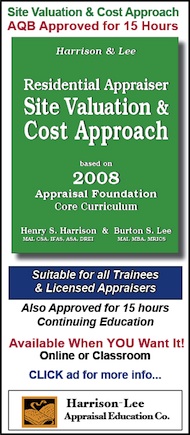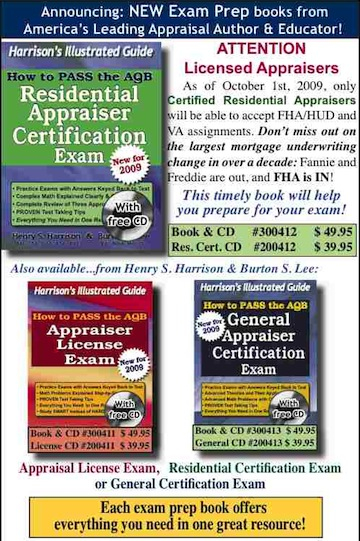Ask Henry
Dear Henry,
First, thanks for the resources on your web site!
I have been asked to do an exterior-only inspection of a home on a 65 acre site in a rural location for loss mitigation. I have the assessor cards on the property, so I have some basic information, but their last inspection was several years ago. The property is behind locked gates and not at all visible from any point. I have asked to have this assignment upgraded to a full report, but the lender also does not have access and wants to proceed with a driveby only. Can I effectively do this using extraordinary assumptions with so many unknowns?
Tom Trojnar
ttrojnar@earthlink.net
Dear Tom,
This is a judgment you have to make.The USPAP requires that you make a credible appraisal. I would tell the client (preferably in writing) what extraordinary assumptions will need to be made to do this assignment, and get their pre-approval (again preferably in writing). Keep in mind that this appraisal may lead to a variety of problems and the lender may blame them on you. You need to ask yourself if it s important enough to your business relationship with the client to expose yourself to possible future trouble that may occur. Finally, the type of report does not have any effect on what you have to do to make a credible appraisal.
Good luck!
Rave
Thank You, Henry!
Since becoming a Massachusetts Certified Residential Real Estate Appraiser eleven years ago, I have relied on your publications more than any other resource! You are a wealth of knowledge and a leader in our profession. I have thoroughly enjoyed your inaugural Blog.
Susan Lyman
solyman1@verizon.net
Ask Henry
Dear Henry:
On page one of the FNMA 1075 form is a section titled "Project Site". At the conclusion of this section, the following question is asked of the appraiser: "Are there any adverse site conditions or external factors (easements, encroachments, environmental conditions, land uses, etc.)?". Question: If the subject of the appraisal is located on the perimeter of the condo complex and fronts onto a traffic street, while a majority of the remaining units are located within the interior of the complex and are not impacted by any traffic noise, is the answer to this question "yes" or "no"? In the past, I've always looked upon this section of the report as focusing more on factors that would "impact the complex as a whole", for example, an easement for high power lines that run through a complex (EMFs), or a complex that was built upon a site that has an abnormally high water table and resultant wet basements.
Dennis J. McCarthy
djmccarthy@cox.net
CA State Certified Res. Appraiser
Dear Dennis,
In my opinion, when in doubt about anything that might be adverse to a property, you have to report it. In this case, there are some problems that affect part of the site where your subject unit is located. You should report this, and then go on to explain how the problem specifically affects the subject unit you are appraising, in terms of desirability and competition in the market.
As far as "Yes" and "No" answers go you must be very careful about checking the "No" box. It is much safer to check the "Yes" and indicate with a asterisk that in the comments section or the addenda there are comments that explain why you checked the "Yes" box. Here you can explain what effect (if any) what you are reporting has on the value of the subject property.
Sound Off!
Lots of talk about regression analysis these days. Wonderful stuff that can be a useful tool. Like the form 1004MC, however, regression analysis is subject to the same pitfalls. Data input, the size of the sample, and the distance encompassed determine the results. Who determines the input?
When all is said and done, there is no substitute for experience, honesty, and integrity. We should have learned from the Savings and Loan fiasco that appraisers hold the very financial welfare of the country in their hands. Despite some efforts, the pressure to "sell money" remains an undue influence that continues to lead to disaster. How is it that the largest holders of residential debt, $150 billion in bad debt (and climbing), continue to have an undue influence on writing the rules? I know there's a lot of political pressure; however, someone has to step up and say "enough is enough".
I am but a voice in the wilderness - but maybe Henry Harrison can open a few eyes and ears of those with some influence?!
Joe Johnson
Certified Residential Appraiser, FL
jjohns58@verizon.net
Ask Henry
Good Morning, Henry,
I am doing an appraisal on a property that is a model home center. The buyer is leasing back the property to the seller for a period of at least 12 months. This is stipulated in the contract, and I am wondering if the leaseback is considered a Sales Concession and inserted on page 1 of the appraisal report under Seller Concessions since the buyer is in effect contracting with the seller. The seller is paying 2% of the buyer's closing costs which obviously is a sales concessions, but I'm unsure if this is the area of the report where I should insert the information regarding the leaseback as well. The purchase price is $550,000 and the monthly leaseback is $5,350.
Thanks in advance for your input,
Ben Powell
bpowell7@tampabay.rr.com
Dear Ben,
In answer your question, paying 2% of the buyer's closing costs is not a very big sales concession if the seller is going to get to use the property for another year. However, if the rent the seller is paying to the buyer is above market rent, then that would make it a sales concession as well. You need to consider both the payment of part of the closing costs and the terms of the leaseback in order to decide if it is a sales concession. Then you have the tricky job of putting a dollar value on both types of sales concessions.
If you think the leaseback rental is above market rent, then it is a seller concession. It is a judgment you must make based on comparable rentals in your market area. What about the price? Was it adjusted downward so the developer could have the use of the house for the year? If so, that would also be a type of sales concession. My advice is to carefully note each of these concessions separately, including all terms that apply, along with your opinion about their impact on your value estimate for the subject property. Where you put the information is less important than being sure you are including it all. You may do best if you add a custom addendum regarding the concessions.
Editorial
In my Editorial in the Fall 2010 online issue of Real Estate Valuation Magazine, I addressed the issue of whether we still need Fannie Mae and Freddie Mac. I offered some solutions as to what I felt would be a prudent solution to Fannie and Freddie's future.
This week, President Obama released the Administration’s plan for dealing with Freddie and Fannie in the context of the entire home mortgage market, entitled “Reforming America’s Housing Finance Market – A Report to Congress, February 2011."
Some of the report's major recommendations include:
- Winding down Fannie and Freddie to a revised role in the mortgage market
- Implementing immediate improvements to mortgage servicing and foreclosure processing by establishing national standards for both activities
- Setting goals and targets to reduce the FHA's role in new mortgage production.
- Reducing conforming loan limits.
- Reducing the portfolio size of mortgages held by government housing finance agencies.
- Increasing the required down payment to a minimum of 10% over a phase-in period.
- Raising insurance premiums for government guarantees on mortgage products.
- Returning FHA to its traditional role as the target lender of affordable mortgages.
- Using the Consumer Financial Protection Bureau (CFPB) to empower consumers to make better informed decisions and avoid unfair lending practices.
- Reforming the securitization market for home financing by increasing its regulation and monitoring.
- Reforming servicing compensation and mortgages to eliminate the differences between first and second mortgages.
- Revising goals and practices for how affordable housing and rentals will be supported by the government.
This is an overview of the Administration’s plan, which must be passed by Congress before it can be implemented. It affects the well being of some of the most powerful corporations and other interests in the country, represented by very powerful lobbies. In addition, the views of the political parties are very far apart on what needs to be done. This plan is just the first step in what is going to be a long and hard battle in Congress.
The entire Obama proposal (31 pages), which is summarized in this article, can be downloaded by clicking here.
My editorial containing some different ideas about what should be done is available in the Fall 2010 REV Magazine, downloadable at: http://www.revmag.com/downloads
HSH
askhenryharrison@revmag.com
News
on the Administration’s Housing Finance Reform Report
“I am pleased that the Administration today put forward a framework to strengthen the nation’s housing finance system, restore the critical role of private capital, and identify options for the long-term structure of housing finance.
The conservatorships of Fannie Mae and Freddie Mac, with funding from the Treasury Department, were put in place to provide near-term stability to the mortgage market and to give policymakers an opportunity to evaluate the role of the government in housing finance. Currently, the Federal government is providing support for over 90 percent of new mortgage originations, a level of involvement that should not be maintained.
As debate over the future of the housing finance system progresses, FHFA will continue to meet the goals of the conservatorships, which include retaining value in the Enterprises’ business operations and maintaining their support for the housing market. Since the conservatorships were established, the Enterprises have strengthened their underwriting standards and enhanced their loss mitigation tools. The work of FHFA is consistent with the Administration’s focus on stronger underwriting and pricing, and the re-introduction of private capital.
Certain elements of the Administration’s framework involve preparing the Enterprises, the Federal Home Loan Banks, and other market participants for the transition to a future structure for housing finance. We will consider and discuss with the Administration the details of the framework announced today, consistent with our responsibilities as conservator and regulator. FHFA also will continue to take other steps to strengthen the mortgage market of the future. For example, we have already initiated programs to standardize mortgage data submissions and consider servicing compensation reforms.
FHFA looks forward to working with the Administration and Congress to restore the functioning of private markets and preserve the stability and liquidity of the secondary mortgage market.”
###
The Federal Housing Finance Agency regulates Fannie Mae, Freddie Mac and the 12 Federal Home Loan Banks. These government-sponsored enterprises provide more than $5.9 trillion in funding for the U.S. mortgage markets and financial institutions.
Ask Henry
Greetings Henry,
Over the years I have appraised a few rural properties that have possessed small vineyards. In every case, the owner has claimed the vineyard was not for commercial use, it was for hobby use only -- or, that there was only a very small "incidental income" attributable to the vineyard. Is there any hard criteria that can be applied in determining if the highest and best use is commercial wine production, based on the # of vines, etc. In discussions with other appraisers, it has always seemed to be a grey area with lots of appraiser discretion.
Regards,
Rick Bacich
rickbacich@mail.ssctv.net
Dear Rick,
My daughter Kate did her college thesis at Vassar based on a survey of organic farms in the Hudson Valley in upstate New York, which is a wealthy semi-rural area. Her conclusion was that after you assigned some cost to the labor by the owners, the farms were not making any money at all! A well-known real estate author moved south with her husband to run a vineyard they had purchased. When I saw her at an educators' convention, she lamented that she made more money selling the grapes from a farm stand than she could by producing wine. Last I heard, they'd sold the vineyard and given up. There's lots more anecdotal evidence that indicates what the owners are telling you is true.
You might try the Lum Appraisal Library, 550 W. Van Buren Street, Suite 1000, Chicago, IL 60607; (312) 335-4100 to see what has been published on the subject. The librarians there are knowledgeable and helpful.
Rave
Been in this business since 1979 ... HH -- you have been there for us with forms (before computers), advice and the most intelligent outlook on the appraisal business, way better than any of the "suits" and "academics". It's true that icons eventually move on, but never retire. This business needs you, HH -- more than ever!! Keep up the great work...
Carol Wolfe, SRA
Certified General Appraiser, Colorado
cbwolfe2000@comcast.net
Sound Off!
A Response to your Editorial posted 2/2/2011:
Dear Henry!
I completely agree with your analysis -- except it's too late to rein in the Big Banks. They've already spent the money on their bailouts, bonuses, expense accounts, etc., and left the taxpayers are on the hook for every penny.
In my humble opinion, this would never have happened if the Justice Department had done its job properly back in the 1980s during the Savings and Loan debacle, and publicly tried and convicted 4 of the Keating 5, then thrown them in jail for a nice long cooling off period...say 5-10 years!?
When the sleazy creeps at the Banks and on Wall Street found out that only 1 high profile bigshot was going to "do time," it was a clear signal: "Go for it, 'cause they won't do anything except slap us on the wrist."
Leland Turner
xleland@yahoo.com
CA
Ask Henry
Dear Henry,
For the first time in my 26 years of appraising, a complaint regarding the quality of my work has been submitted to the Better Business Bureau. I am compelled to answer the complaint, which involves 2 different clients. My only concern is that my response will be on the webpage for everyone in the world to read. Will I be violating USAP Standards on confidentiality to my clients? Please give me your thoughts.
LJW
Information withheld by request
Dear LJ:
There is nothing I know of that compels you to answer this complaint. However, if you decide to answer it, I recommend saying that the appraisal is your professional opinion, and that the confidentiality provisions of the USPAP prohibit your discussing the appraisal with anyone other than your client.
Ask Henry
Dear H2,
I am appraising a condo where the mortgage is held by a small bank in the developer's portfolio. The original appraisal was for $1,623,424 a few years ago. The bank requires that these appraisals be redone every few years. This is a 3,905 sq. ft. very upscale penthouse with a private elevator. It is on the fourth floor of a four-story building with a woodland view, but is just a five minute walk to one of the largest shopping malls amd upscale business centers in the greater Atlanta area. Location is excellent. The value of the condos in the subject building have declined as out-of-town buyers have walked away from what they thought were rental investment properties. The original prices were from about $750,000 to $1,700,000. After a series of foreclosures, the units have been selling for $200K - 300K and a few lower. I have a comp less than a mile from a competing building that is $2,024,300. It is almost identical to the subject unit, but has no elevator. Other than that, there's nothing anywhere close by. Also, taking into consideration the state of the subject condo, I just don't know where to start to do this appraisal. The workmanship is excellent and this five year old unit which is owned by the developer is like new, as he has hardly ever been there. I have not ever been faced in 28 years with such a challenge. Could you give me some guidelines?
June Ortiz
june.ortiz@comcast.net
Dear June,
What you are describing is happening in many market areas throughout the country. What makes your question difficult is you offer no explanation of why the one comparable sale seems to be so different from the rest of the market in which your property is located. Your appraisal has to be based on all of the known comparable sales in your market area from which you select the ones that you believe are most comparable. What the subject sold for historically must be reported, but has no bearing on its current value. You have to make a judgment as to how much weight to give this one sale that seems to differ from the rest of the comparables in the subject condo complex. At a minimum, you must verify that sale and try to find out from your verification source(s) why the buyer was willing to pay so much money.
Ask Henry
Dear H2,
I am looking for a copy of your book entitled Harrison’s Illustrated Guide How to Pass the AQB Residential Appraisal Certification Exam. I have been unable to find it in any book stores. Any help would be great!
Thank you,
Eddy L. Arnold
eddylarnold@wi.rr.com
Dear Eddy,
The current edition of this book -- and any of my other my other guides and books -- is available from Forms and Worms, online at: www.formsandworms.com or you can call them toll-free at: 1-800 243-4545.
Ask Henry
Dear H2,
On a current appraisal, after all adjustments are made in the sales comparison grid of the URAR, the end adjusted values are as follows: Comp1: $125,000 - Comp 2: $127,000 - Comp 3: $124,000. I am unable to accord weight to any one of the comparables and would like to give weight to all of them, using an average that is in the middle of the indicated value range ($124,000-$127,000). I would like to add all three indicated values, and divide by three (= $125,333 average) and then reconcile the values to be $125,000.
However, I’ve been told many times not to derive an opinion of value using a mathematical method such as this one. Yet I have seen a few appraisals of my peers that do use this method, where appropriate. Of course, I want to be in compliance with Fannie/Freddie and USPAP. What's your opinion?
Brooke
Dear Brooke,
If you are using a URAR form, the format calls for you to describe each comparable sale and then adjust it for any significant differences between it and the subject property. However, there is nothing in the USPAP that requires you to analyze comparables this way. In more complex appraisals (usually reported in a narrative appraisal report format), I have seen large sets of comparable data adjusted using averages. What you plan to do is fine, but the final value estimate of the subject should be based upon a reconciliation that, in your judgment considers everything about the subject, market and comparables that you think is significant.
The reason an "average" is not usually used by appraisers in the reconciliation process is that it is a statistical term that implies that you took a random sample of all the available comparable sales, and that the sample was large enough (usually a minimum random sample is at least 18 items). You would then also need to state if the average you obtained is the mean, median or mode.
News

- The Handbook of Chinese Horoscopes by Theodora Lau, Harper & Row Perennial, 1979.
Editorial
The public relations firms of the big banks in the United States and England are busily grinding out PR releases, trying to convince us that they are critical to reducing unemployment and jump starting our economy. It reminds me of the old joke about the person who murdered his parents telling the judge to show mercy because he is an orphan!
There are many institutions who shared in the creation of the economic mess we are now in, that directly affects appraisers and impacts the future of our profession. My nomination for the top of the list of miscreants are the "big banks." Admittedly, they had lots of company in enabling the housing market implosion, but without their profligate involvement, the subprime mess might have been avoided. The resulting foreclosures and the continuing slow recovery, as well as the malignant unemployment problem, are directly linked to their greed and disregard of everyone’s economic well being — except their own, of course... Read More...
Ask Henry
Dear Mr. Harrison:
This is my first question for you. I'm a Certified Residential appraiser in MA and N.H. Can I just go to the govt. website to become FHA approved? Is it that simple? Could you advise me please? I enjoy your Revmag emails I receive.
Thank you in advance for your help.
John D. Devereaux
jaydev@charter.net
Dear John,
The FHA website: http://www.hud.gov/offices/hsg/sfh/appr/eligibility.cfm tells you in detail what you need to do to get on the FHA Roster of Approved Appraisers.
If that doesn't work, go to Google and enter the phrase "FHA Appraiser Roster". There is an application but is cannot be completed online. Your completed application must be submitted online, which means that you have to download the application and save it as a PDF, sign it and then scan it and send it back via email to the FHA.
Here are the highlights of the current FHA requirements:
1. You must be a residential certified appraiser or general certified appraiser.
2. You must NOT be listed on GSA's Excluded Parties List System (EPLS),
HUD's Limited Denial of Participation (LDP) list, or HUD's Credit Alert System (CAIVRS).
3. You must scan your state issued certification and send it with your complete online application.
4. Make sure that the ASC National Registry contains the correct information about your certification.
The $64-thousand dollar question is what happens next! Hopefully some of our readers will share their experience -- especially how long it took them to get on the FHA roster once they had applied.
Good luck!
HSH
askhenryharrison@revmag.com












